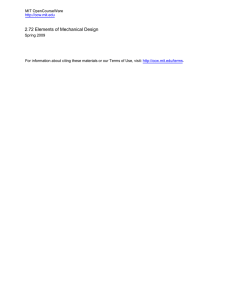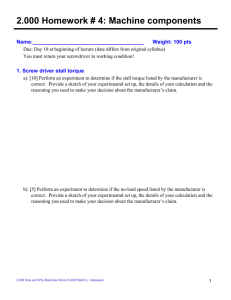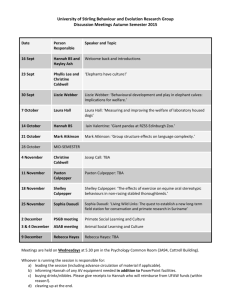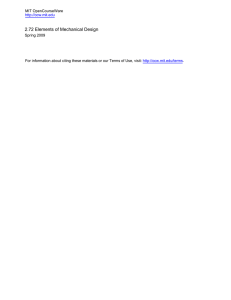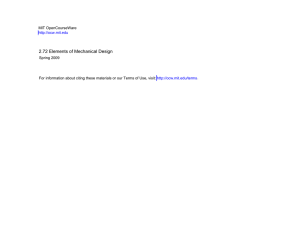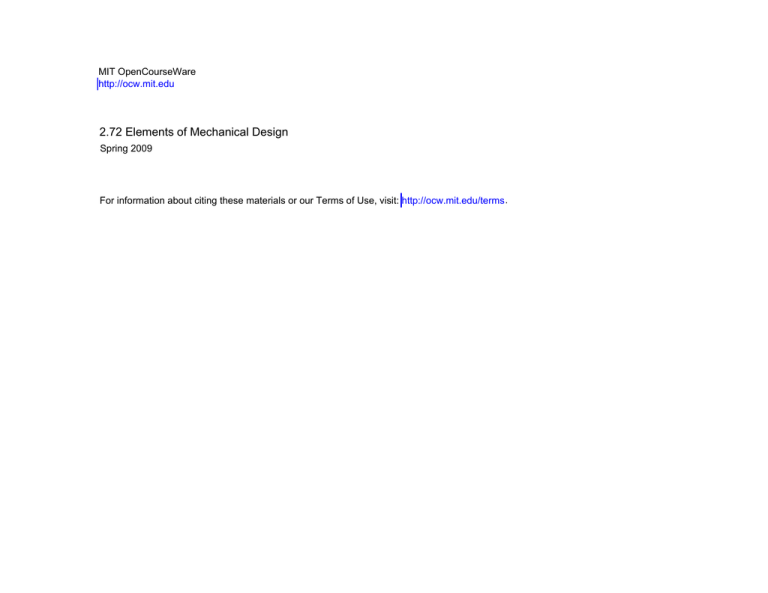
MIT OpenCourseWare
http://ocw.mit.edu
2.72 Elements of Mechanical Design
Spring 2009
For information about citing these materials or our Terms of Use, visit: http://ocw.mit.edu/terms.
2.72
Elements of
Mechanical Design
Lecture 13:
Gear failure prevention
Schedule and reading assignment
Quiz
Activity at end: Optional/Extra credit
Images removed due to copyright restrictions.
Please see images of very large and very small gears, such as:
Topics
http://mems.sandia.gov/gallery/images_gears_and_transmissions.html
http://www.cage-gear.com/large_gear_cutting.htm
Gear lifetime/selection
Reading assignment
None!
© Martin Culpepper, All rights reserved
2
Selection vs. design of gears
It is rare to custom DESIGN a gear.
Many gear selection programs…
Anybody can read S/M and plug in #s
BASIC considerations to select gears:
Ensure geometric compatibility (e.g. equal pitch and same type)
Avoid low-cycle failure (e.g. root stress)
Avoid high-cycle failure (e.g. pitting)
Focus on what is important
© Martin Culpepper, All rights reserved
3
A failure…
© Martin Culpepper, All rights reserved
4
How to model the gear teeth…
W
Wr
Wt
Wt
F
l
rf
t
a
x
l
Figure by MIT OpenCourseWare.
© Martin Culpepper, All rights reserved
t
Figure by MIT OpenCourseWare.
5
Gear
manufacturing
Gear manufacturing - Hobbing
© Martin Culpepper, All rights reserved
Please see digtos. "GEAR HOBBING M20/32 CITIZEN CINCOM."
February 17, 2008. YouTube. Accessed October 26, 2009. http://www.youtube.com/watch?v=fR2duvm3lPo
7
Gear manufacturing - Shaping
© Martin Culpepper, All rights reserved
9
Please see rolvon. "Gear Cutting." May 16, 2008. YouTube. Accessed October 26, 2009. http://www.youtube.com/watch?v=xF9CjluRFJ4
Selection vs. design of gears
Why do we care about gear tooth surface finish
What affects the finish on the gear surfaces?
How good could it be?
How much would it cost?
Why do we care about the tooth geometry at the root
What affects the quality of the fillet at the root?
How good could it be?
How much would it cost?
© Martin Culpepper, All rights reserved
10
Perspective
Failure modes
Tooth bending/shear
Contact failure
Science modeling
→
Engineering modeling
American Gear Manufacturers Association (AGMA)
Example
Single pressure angle
Full-depth teeth
Others
© Martin Culpepper, All rights reserved
11
Calculating stresses
σ bending
Pd K m K B
= Wt K o K v K s
(U.S. units)
F J
1.9
Dynamic factor, kv
1.8
Qv = 5
1.7
Qv = 6
1.6
Qv = 7
1.5
1.4
Qv = 8
Qv = 9
1.3
Qv = 10
1.2
Qv = 11
1.1
1.0
"Very accurate gearing"
0
2000
4000
6000
8000
10,000
Pitch line velocity, Vt, ft/min
Figure by MIT OpenCourseWare. Adapted from Fig. 14-9 in Shigley & Mischke.
σ contact = C p
Km C f
(Wt K o K v K s )
(U.S. units)
dp F I
Incredibly uninteresting, plug-chug & ‘non-scientific’
© Martin Culpepper, All rights reserved
12
Gear failure
at the root
Bending
Basic stress calculation
Stress near the tooth root, model tooth as a cantilever
Mc
σ=
I
Wt P
σ=
FY
6 Wt L
σ=
F t2
Root
P: Diametral pitch
Y: Lewis form factor
~¼ to ½ for φ = 20o
f( # of teeth )
Conservative:
Implies that one tooth carries the load
Heaviest load occurs mid-tooth
© Martin Culpepper, All rights reserved
14
Basic stress calculation
Stress near the tooth root, model tooth as a cantilever
M c
σ =
I
Wt P
σ=
FY
6 Wt L
σ=
F t2
W
Wt
F
Wr
Wt
l
t
P: Diametral pitch
Y: Lewis form factor
~¼ to ½ for φ = 20o
f( # of teeth )
rf
a
l
x
t
Figure by MIT OpenCourseWare.
Figure by MIT OpenCourseWare.
Image removed due to copyright restrictions. Please see
http://www.oilanalysis.com/Backup/200101/Gear3.jpg
Conservative:
Implies that one tooth carries the load
Heaviest load occurs mid-tooth
© Martin Culpepper, All rights reserved
15
Dynamic effects
How to incorporate dynamic effects
One way of addressing
⎛
a + V
K
v = ⎜⎜
⎝
a
V = pitch line velocity
Kv depends on fab
b
c
⎞
⎟⎟
⎠
For rough estimates
Wt P
σ = KV
FY
This is for English units, for SI is different
© Martin Culpepper, All rights reserved
16
Allowable bending stress
Allowable bending stress number, St kpsi
These types of plots are associated with conditions
50
Grade 2
St = 102 HB + 16 400 psi
40
Grade 1
St = 77.3 HB + 12 800 psi
30
St = αt . Hb + Ct
20
10
150
200
250
300
350
Brinell hardness, HB
400
450
Figure by MIT OpenCourseWare. Adapted from Fig. 14-2 in Shigley & Mischke.
© Martin Culpepper, All rights reserved
17
Allowable bending stress
σ all
S t YN
=
(U.S. units)
S F KT K R
σ all
St YN
=
(SI units)
S F Yθ YZ
Elements of the equations:
St
YN
KT
KR
SF
Allowable bending stress
Stress cycle life factor
Temperature factors
Reliability factors
AGMA factor of safety
Allowable stresses for:
Unidirectional loading
10 million stress cycles
99 percent reliability
© Martin Culpepper, All rights reserved
18
Gear failure
at the surface
Fatigue
High cycle failure: Pitting
Images removed due to copyright restrictions. Please see any photos of surface pitting in gears, such as:
http://2.bp.blogspot.com/_tBh5ORa6LOk/R8UaDR3pgVI/AAAAAAAAAGE/DikmlvWPS84/s1600-h/pitting.gif
http://commons.wikimedia.org/wiki/File:Roue_creuse_03.jpg
© Martin Culpepper, All rights reserved
20
Avoiding high cycle failure: Stress variables
Equivalent modulus
1
Ee =
2
2
1 − v1 1 − v21
+
E1
E2
Half contact width
2Wt d1 d 2
b=
π L Ee (d1 + d 2 )
υ = 0.333
Watch out! The book
switches meaning of F here…
Maximum contact pressure
2Wt
q=
π bL
Image from Wikimedia Commons, http://commons.wikimedia.org
© Martin Culpepper, All rights reserved
21
Allowable contact stress [ANSI/AGMA 2001-D04 and 2101-D04]
Allowable contact stress number, Sc
1000 lb/in2
S c = α c ⋅ H b + Cc
175
Grade 2
Sc = 349 HB + 34 300 psi
150
125
Grade 1
Sc = 322 HB + 29 100 psi
100
75
150
200
250
300
350
400
450
Brinell hardness, HB
22
© Martin Culpepper, All rights reserved
Figure by MIT OpenCourseWare. Adapted from Fig. 14-5 in Shigley & Mischke.
Allowable contact stress
σ c,all
SC Z N C H
=
(U .S . units )
S H KT K R
σ c,all
S C Z N ZW
=
(SI units)
S H Yθ YZ
Elements of the equations:
SC
ZN
CH
KT
KR
SH
Allowable contact stress
Stress cycle life factor
Hardness ratio factors for pitting resistance
Temperature factors
Reliability factors
AGMA factor of safety
Allowable stresses for:
Unidirectional loading
10 million stress cycles
99 percent reliability
© Martin Culpepper, All rights reserved
23
Exercise
Gears
General machine design
Activity: Refit lathes for the mfg. shop
Study the lathes in the shop…
1. What types of failures do we have?
2. Calcs/sims/tests need to augment Shigley/Mischke:
Gearing
Belts
Friction elements
3. Worst case consequence of these kinds of failures:
Pitting failure
Tool break/failure
Fatigure
© Martin Culpepper, All rights reserved
25
Exercise
Windmill gear boxes
Windmill failures: Catastrophic
Please see mrturbodk. "windmill failure." February 28, 2008. YouTube. Accessed
October 26, 2009.
© Martin Culpepper, All rights reserved
http://www.youtube.com/watch?v=TmM3KQnFmXs
27
Wind energy overview: Lakawona
Images removed due to copyright restrictions. Please see
http://i124.photobucket.com/albums/p7/NBBooks/WTGTurbinesGettingLargerSM.jpg
http://i124.photobucket.com/albums/p7/NBBooks/WTGUSWindResources.jpg
© Martin Culpepper, All rights reserved
28
Images removed due to copyright restrictions. Please see p. 19 in
http://www.clipperwind.com/pdf/liberty_brochure.pdf
© Martin Culpepper, All rights reserved
29
Activity: Extra credit - As a group
You are tasked to build a windfarm off Cape Cod
1. Shigley/Mischke is not perfectly suited to cover gear
needs in this application. Why/how?
2. What calculations/simulations/tests would you do to
augment Shigley/Mischke?
3. What happens if you have pitting failure and what
would you do about it?
4. What happens if you have failure at a tooth root and
what would you do about it?
© Martin Culpepper, All rights reserved
30

